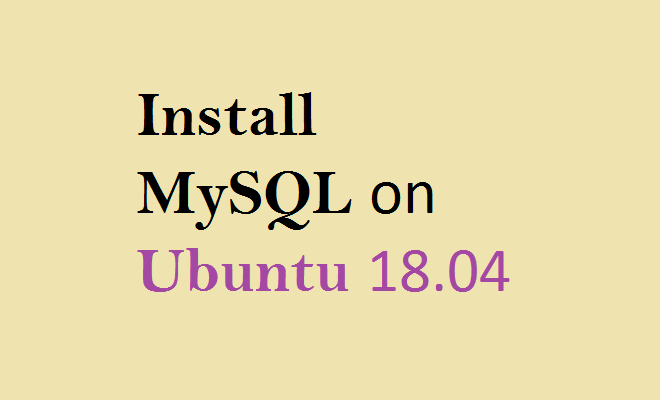
MySQL is an open-source database management system, commonly installed as part of the popular LAMP (Linux, Apache, MySQL, PHP/Python/Perl) stack. It uses a relational database and SQL (Structured Query Language) to manage its data.
In this guide you'll learn how to install MySQL version 5.7 on an Ubuntu 18.04 server.
Prerequisites
To follow the steps mentioned in this guide, you will need one Ubuntu 18.04 server set up by following our basic server setup guide, including a sudo non-root user and a firewall on Ubuntu 18.04.
Installing MySQL
On Ubuntu 18.04, only the latest version of MySQL is included in the APT package repository by default. At the time of writing this article, the latest version was MySQL 5.7. To install it, update the package index on your server and install the default package with apt:
sudo apt update
sudo apt install mysql-server
This will install MySQL, but will not prompt you to set a password or make any other configuration changes. Because this leaves your installation of MySQL insecure, we will cover this in next step.
Configuring MySQL
For fresh installations, you'll want to run the included security script. This changes some of the less secure default options for things like remote root logins and sample users. On older versions of MySQL, you needed to initialize the data directory manually as well, but this is done automatically now.
Run the security script:
sudo mysql_secure_installation
This will take you through a series of prompts where you can make some changes to your MySQL installation’s security options. The first prompt will ask whether you’d like to set up the Validate Password Plugin, which can be used to test the strength of your MySQL password. Regardless of your choice, the next prompt will be to set a password for the MySQL root user. Enter and then confirm a secure password of your choice.
From there, you can press Y and then ENTER to accept the defaults for all the subsequent questions. This will remove some anonymous users and the test database, disable remote root logins, and load these new rules so that MySQL immediately respects the changes you have made.
To initialize the MySQL data directory, you would use mysql_install_db for versions before 5.7.6, and mysqld --initialize for 5.7.6 and later. However, if you installed MySQL from the Debian distribution, as described above, the data directory was initialized automatically; you don't have to do anything. If you try running the command anyway, you'll see the following error:
Output
2018-05-07T12:44:16.998193Z 0 [ERROR] --initialize specified but the data directory has files in it. Aborting.
Finally, let's test the MySQL installation.
Testing MySQL
Regardless of how you installed it, MySQL should have started running automatically. To test this, check its status.
systemctl status mysql.service
You'll see output similar to the following:
Output
● mysql.service - MySQL Community Server
Loaded: loaded (/lib/systemd/system/mysql.service; enabled; vendor preset: en
Active: active (running) since Wed 2018-05-07 12:45:26 UTC; 10min ago
Main PID: 3754 (mysqld)
Tasks: 28
Memory: 142.3M
CPU: 1.994s
CGroup: /system.slice/mysql.service
└─3754 /usr/sbin/mysqld
If MySQL isn't running, you can start it with sudo systemctl start mysql.
For an additional check, you can try connecting to the database using the mysqladmin tool, which is a client that lets you run administrative commands. For example, this command says to connect to MySQL as root (-u root), prompt for a password (-p), and return the version.
sudo mysqladmin -p -u root version
You should see output similar to this:
Output
mysqladmin Ver 8.42 Distrib 5.7.21, for Linux on x86_64
Copyright (c) 2000, 2018, Oracle and/or its affiliates. All rights reserved.
Oracle is a registered trademark of Oracle Corporation and/or its
affiliates. Other names may be trademarks of their respective
owners.
Server version 5.7.21-1ubuntu1
Protocol version 10
Connection Localhost via UNIX socket
UNIX socket /var/run/mysqld/mysqld.sock
Uptime: 30 min 54 sec
Threads: 1 Questions: 12 Slow queries: 0 Opens: 115 Flush tables: 1 Open tables: 34 Queries per second avg: 0.006
This means MySQL is up and running.
Wrapping up
You now have a basic MySQL setup installed on your Ubuntu 18.04 server.